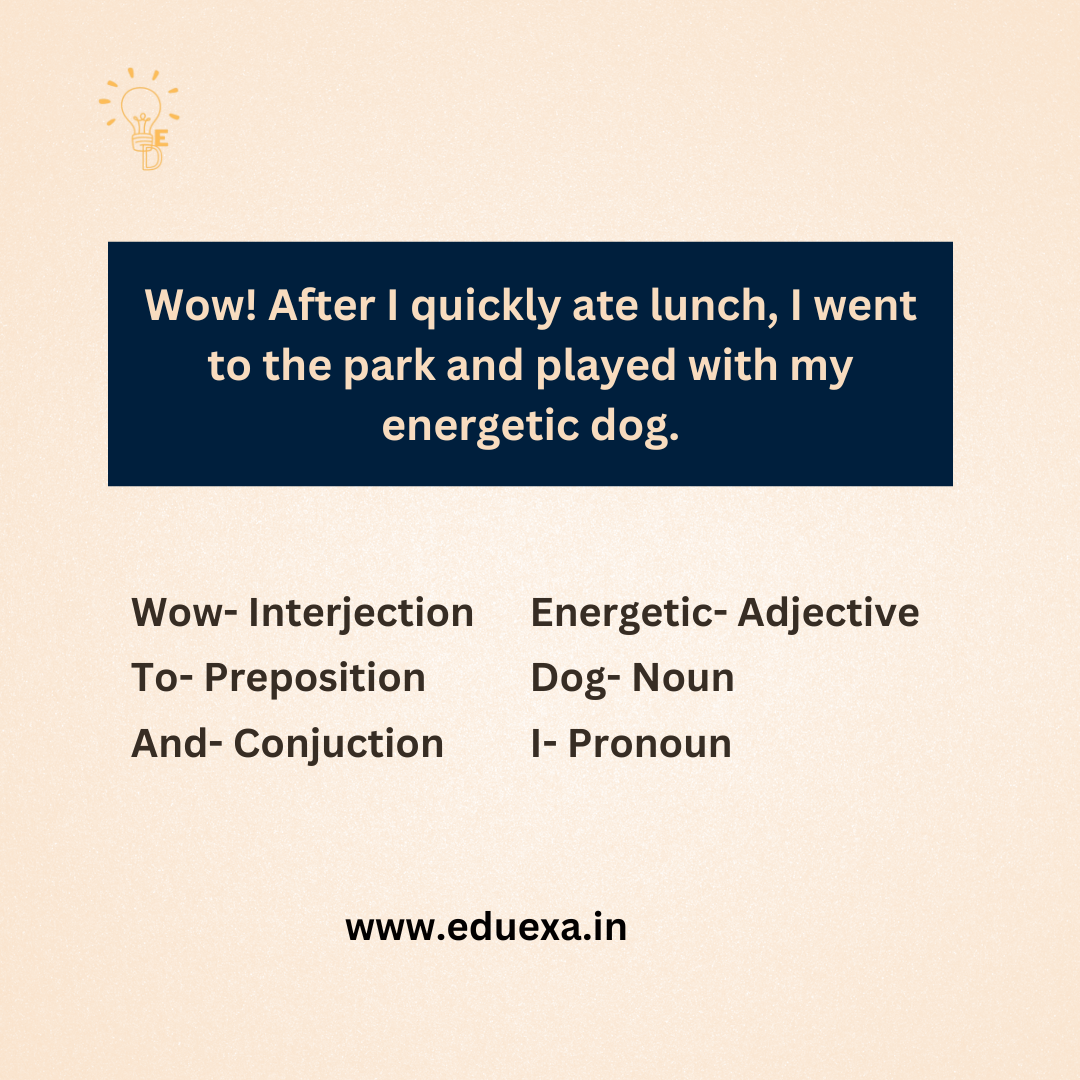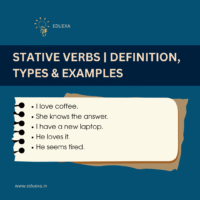Undoubtedly, English is a funny language that keeps us entertaining with its quirks, contradictions and twists. But you need to master this funny language for clearing your exams be it Indian exams like SSC, CUET or international exams like IELTS, TOEFL, Duolingo etc. Understanding the Parts of Speech is fundamental to mastering English grammar.
Parts of speech are the foundation stone of English, every word you read, write, or speak fits into one of these categories, which define its function and placement in a sentence. Whether you’re a beginner or brushing up your grammar, learning the parts of speech will help you form clear, grammatically correct sentences and enhance your fluency. In this comprehensive guide, we’ll break down each part of speech with clear definitions, examples, and tips for usage.
What Are the Parts of Speech?
Parts of Speech refer to the categories into which words are classified based on their roles or functions in sentences. These are the cornerstones of English which help in forming grammatically correct sentences. English grammar traditionally recognizes eight main parts of speech:
| Noun | Pronoun |
| Verb | Adjective |
| Adverb | Preposition |
| Conjunction | Interjections |
Let’s explore each one in detail with definitions and examples.

1. Noun
Definition: I am sure each one of us remembers what noun is since class 1. Okay, yes, a noun is a word that names a person, place, thing, or idea.
Examples:
Person: Doctors, Teachers, Riya,
Place: Delhi, India, Usa
Thing: Chair, Table, Rubber bands
Idea: Happiness, Freedom, Love
Common Noun Vs Proper Noun
Common nouns describe general category or names such as Planets, stars etc whereas the proper noun describes a specific thing/person/place such as Jupiter, Sun.
Concrete Noun Vs Abstract noun
Concrete nouns specify concrete objects whereas abstract noun specifies abstract emotions or feelings.
Examples
Concrete noun: She gave me beautiful flowers.
Abstract noun: Anger kills relations.
Tip: Nouns can be singular or plural and can act as the subject or object in a sentence.
2. Pronoun
Definition: Every person has a replacement so does our “Noun”. A pronoun replaces a noun to avoid repetition.
Examples:
he, she, it, they, we, you, I, them, who, which
Sentence Examples:
1. Riya topped the class. She is very diligent.
2. I have kept the apple on the table. Can you please keep it in the fridge?
Types of pronouns
Pronouns fall into the following categories:
- Subjective: I, he, she, we
- Objective: me, him, her, us
- Possessive: mine, yours, theirs
- Demonstrative: this, that, these
Tip: Ensure pronouns clearly refer to a specific noun (the antecedent).
3. Verb
Definition: A verb expresses an action or a state of being.
Examples:
run, eat, write, is, are, feel, seem, become
Action verbs Vs Non action Verbs
Actions Verbs are those verbs which directly describe an action.
Example: He cooks his own food.
Non Action Verbs do not directly describe an action instead it describes the state of being or state of doing an action.
Example: I am feeling cold.
Transitive Verbs Vs Intransitive Verbs
Verbs can also be transitive or intransitive. A transitive verb is an action verb that requires a direct object to complete its meaning. Intransitive Verbs does not require direct object to complete its meaning.
Transitive: He closed the door.
Intransitive: She cooks.
Tip: Verbs change form to show tense, number, and mood.
“Also learn about the stative verbs for better understanding.”
4. Adjective
Definition: An adjective describes or modifies a noun or pronoun.
Examples:
blue, tall, intelligent, three, beautiful
Sentence Examples:
The red balloon flew away.
She wore a beautiful dress.
Types of adjectives
Adjectives fall into the following categories:
- Descriptive: red, large, cheerful
- Quantitative: many, three, few
- Comparative: taller, more beautiful
- Superlative: tallest, most beautiful
Tip: Adjectives often answer: Which one? What kind? How many?
5. Adverb
Definition: An adverb modifies a verb, an adjective, or another adverb. It describes an adjective or noun or another adverb. Simply speaking, it often tells how, when, where, or to what extent.
Examples:
quickly, very, yesterday, silently, always
Sentence Examples:
He ran quickly.
She is very kind.
Tip: Many adverbs end in -ly, but not all.
6. Preposition
Definition: A preposition shows the relationship of a noun or pronoun to another word in the sentence.
Examples:
in, on, under, over, between, with, at, to
Sentence Examples:
The cat is under the table.
She walked to the store.
Tip: Prepositions are usually followed by a noun or pronoun, forming a prepositional phrase.
7. Conjunction
Definition: A conjunction connects words, phrases, or clauses.
Types:
Coordinating: and, but, or, nor, for, so, yet
Subordinating: because, although, since, unless
Correlative: either…or, neither…nor, both…and
Sentence Examples:
I like tea and coffee.
He left because he was tired.
Tip: Use conjunctions to improve the flow and logic of your writing.
8. Interjection
Definition: An interjection expresses strong emotion or sudden bursts of feeling.
Examples:
Wow, Ouch, Hey, Oh no, Hurray
Sentence Examples:
Wow, that’s amazing.
Oops, I dropped it again.
Tip: Interjections are often followed by an exclamation mark and are not grammatically connected to the rest of the sentence.
Why Understanding Parts of Speech Matters
Knowing the parts of speech helps you:
- Construct grammatically correct sentences
- Improve writing clarity and style
- Understand complex sentence structures
- Prepare for competitive exams (IELTS, TOEFL, SAT, etc.)
“Read about the upcoming government exams in 2025 to stay informed and start preparing on time”
Quick Recap Chart

| Part of Speech | Function | Examples |
| Noun | Names a person/place/thing/idea | dog, school, love |
| Pronoun | Replaces a noun | he, she, it, they |
| Verb | Expresses action/state | run, is, write, eat |
| Adjective | Describes a noun/pronoun | blue, tall, intelligent |
| Adverb | Describes verbs/adjectives | quickly, very, silently |
| Preposition | Shows relationships | in, on, under, between |
| Conjunction | Connects words/phrases | and, but, because, or |
| Interjection | Expresses emotions | Wow, Ouch, Hey |
Practice Sentences (Identify the Parts of Speech)
- I am feeling cold.
- She loves coffee.
- He has decided to leave the city.
- Which language exam is right for you?
- Wow! That bouquet looks so damn pretty!
- I will leave this office but only after I get my offer letter from the other organisation.
- For a moment, I thought it was all real.
- She quickly finished her homework before dinner.
- Although it rained, they went to the park and played.
- The cat slept under the table all afternoon.
Try identifying nouns, verbs, adjectives, adverbs, and more in each sentence.
Final Thoughts
Mastering the Parts of Speech is essential for strong communication skills, whether you’re writing an essay, speaking fluently, or preparing for language tests. Once you’re confident identifying these elements, forming grammatically correct and expressive sentences becomes second nature.
For more grammar tips and learning resources, stay tuned to our blog.
FAQs on Parts of Speech
Q1. How many parts of speech are there in English?
A: There are eight traditional parts of speech.
Q2. Can one word belong to multiple parts of speech?
A: Yes. For example, run can be a verb (I run daily) or a noun (He went for a run).
Q3. What is the difference between an adjective and an adverb?
A: Adjectives describe nouns (a red apple), while adverbs describe verbs, adjectives, or other adverbs (She sings beautifully).
Q4. Why are parts of speech important in English grammar?
A: They form the foundation of sentence construction and help in understanding syntax and grammar rules.


